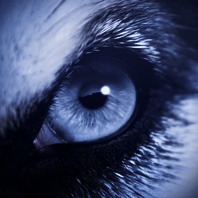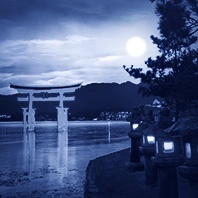Tag:
Language
Japan has a custom, which is called “Tsukimi” or also “Otsukimi” that literally means “moon-viewing” (tsuki = jap. Moon). This tradition dates back to the Heian period (794–1192) where Japanese culture and the arts were refined to a high degree. At that time, elements of the Chinese “Mid-Autumn Moon Festival” were introduced in Japan, and festivals and rituals were held in the eighth sun month (which corresponds to September in our current calendar).
Read more
In the past, we have already reported about the antiquated word »lunatic«, which derives from the Latin »lunatus« and originally means »influenced by the Moon«. This term »lunatic« has been used in the English language, over several centuries for many forms of mental illnesses.
Read more
Who believes to see a staggering Moon at night, has probably had a drop too much, although a staggering movement of the Moon actually exists in astronomy. This is called »libration«, but happens very slowly and is therefore only visible by the naked eye in time-lapse photography.
The Moon orbits around the Earth in a so called synchronous rotation. This means that it always faces one hemisphere towards the Earth, while the reverse side of the Moon is not visible from Earth. Due to certain physical conditions (relating to orbits, angular velocity, centres of mass, among others), what happens is that the visible surface of the Moon varies slightly during the course of the moon cycle, and there is a gentle change of inclination of the Moon’s axis or it appears to turn a little.
Read more
As already mentioned in our article about sleepwalking, a connection was made in the past between the moonlight and people, if their conduct was odd, crazy or threatening. One assumed that the moonlight caused this behaviour and spoke of “lunatic”, which derives from the Latin “lunatus” and means more or less “influenced by the moon”. In English, this terminology “lunatic” has been used for many forms of mental illnesses over many centuries. Because many of these disorders could not be explained for a long time (and there are still plenty of questions today), one was in need of a point of reference, a word that would accompany on the path of darkness. The Moon was very convenient.
Read more
The new moon is the opposite pole to the full moon, being the time when the Moon is not visible in the sky to us people. Maybe this is why we pay less attention to it, because what you don’t see is less prevalent in our awareness.
However, there is one aspect, which continues to lend significance and fascination to the new moon. It is the word »new« and the described moment of renewal and of a new beginning. This word can be found in different languages:
Read more
This is about how to differentiate the waxing moon from the waning moon in the sky. »Waxing« is known to be the lunar phase between the new moon and the full moon (meaning the time when the crescent increases in size), whereas »waning« is known to be the lunar phase between the full moon and the new moon (the time when the crescent decreases in size). In order to remember on which side the curve is, here are some neat mnemonics.
Read more
In many languages, inside the word for the weekday »Monday« you find the word »moon«, sometimes slightly modified but mostly easily recognised. This does not appear to be a coincidence. But why? Surely, the Moon cannot only be seen on Mondays and no other good reasons comes to mind quickly why a specific day of the weekly cycle should be connected to the Moon.
Read more
The Bible is undoubtedly one of the most important books in human history – most printed, most translated and worldwide the most widespread. It is the Holy Scripture of Christianity and Judaism (in different forms) and therefore the manifestation of God’s word in two of the major world religions.
The text contains, with its archaic, poetic language, many descriptions of nature and celestial events. So, it is obvious that the Sun, the Moon and the stars are mentioned. But is the full moon also to be found?
Read more
 We are approaching a more sinister subject, the werewolf, a being that apparently changes from human into a wolf on the full moon. Everyone has heard about it or seen more or less plausible interpretations in movies. Where does this belief stem from? Why a wolf of all animals? And why in the full moon light?
We are approaching a more sinister subject, the werewolf, a being that apparently changes from human into a wolf on the full moon. Everyone has heard about it or seen more or less plausible interpretations in movies. Where does this belief stem from? Why a wolf of all animals? And why in the full moon light?
The word »werewolf« contains, without difficulty to recognise, the »wolf« and the word »were« that translates into »man, human« and can be found in many languages, et al. Old Enlish, Germanic, Old High German and more. So we are talking about a man wolf or a wolfman, someone who can or must take the shape of a wolf. This belief has been widespread in the old days and this had nothing to do with the cliché we are getting to see in horror movies today.
Read more
In German we call the weeks after the wedding »Flitterwochen«, which has really no relevance to the moon. In many languages it is referred to as »honey moon«, which derives from »honey month« and therefore denotes a specific time with particular sweetness after the wedding. However, not always has the connection to the moon been interpreted positively, because one saw in the waning of the Moon the symbol of the decline of attraction that the happy couple would experience during the course of years after the wedding.
Read more








 We are approaching a more sinister subject, the werewolf, a being that apparently changes from human into a wolf on the full moon. Everyone has heard about it or seen more or less plausible interpretations in movies. Where does this belief stem from? Why a wolf of all animals? And why in the full moon light?
We are approaching a more sinister subject, the werewolf, a being that apparently changes from human into a wolf on the full moon. Everyone has heard about it or seen more or less plausible interpretations in movies. Where does this belief stem from? Why a wolf of all animals? And why in the full moon light?
